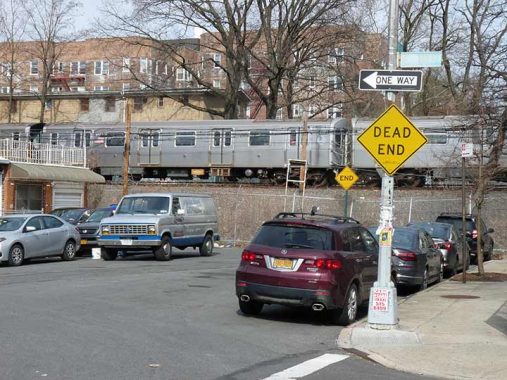
In 1877, the Brooklyn, Flatbush and Coney Island Railway was incorporated, opening the next year in 1878. It originally ran from the Prospect Park entrance at Flatbush and Ocean Avenues south to the Brighton Beach Hotel, built near the water’s edge. The BF&CI wanted to find a way to get its trains closer to downtown Brooklyn. Since a route through Prospect Park was impossible in this pre-subway era, it was decided to build a trench through the hill at Crown Heights (then known as Crow Hill) and run the line below grade, connecting with the Long Island Rail Road tracks at Atlantic Avenue. A contractural agreement with the LIRR allowed BF&CI trains to share its trackage along Atlantic Avenue and the LIRR terminal at Flatbush and Atlantic Avenues, so the BF&CI turned left at Atlantic Avenue.
After 1882, when the LIRR took over a BF&CI competitor, the New York and Manhattan Beach Railroad, it found itself competing with itself for suburban railroad customers. The NY&MB had been created by LIRR chief Austin Corbin before that railroading giant assumed control of the LIRR, and accordingly, the LIRR evicted the BF&CI from its trackage at the end of 1883 after just six years in service. BF&CI service was truncated to the Bedford Terminal at Franklin and Atlantic Avenues, where there was a turntable for turning the steam engines.
No longer having a desirable northern terminal, the BF&CI was forced into bankruptcy and was reorganized in 1887 as the Brooklyn and Brighton Beach Railroad. The next year the Brighton Beach Hotel was moved inland–-by railroad–-to keep it from slipping into the sea. In 1896, the problem of what to do with the northern end of the line was solved when a ramp was built to connect new Kings County Elevated that ran along Fulton Street to the Brooklyn & Brighton Beach from a junction at Franklin and Fulton, bridging Atlantic Avenue and connecting to the Brighton several blocks south of that point. The Fulton elevated ran from downtown Brooklyn over Fulton Street out to Jamaica and was completed in 1893; the connection with the Brooklyn & Brighton Beach completed in 1896 was built to carry the B&BB over its old partner, the LIRR, which was still operating at grade along Atlantic Avenue. This portion of the LIRR was itself submerged in a tunnel under this part of the avenue from 1903-1905. In 1896, the same year the B&BB was leased to the Kings County Elevated, a new entity was created to unite Brooklyn’s surface and elevated lines: the Brooklyn Rapid Transit Company, the BRT.
Beginning in 1905, the Brighton Beach was brought to its present-day arrangement by eliminating all grade crossings. The northern part would be on an elevated structure; south of about Prospect Place, trains would run in an open cut; and south of Foster Avenue, trains would run on an embankment created from land excavated to submerge the Bay Ridge Branch of the LIRR in its own open cut. Many cross streets would be depressed to travel under the embankment, but some would stop at the embankment, vexing travelers to this day. Brighton Beach BRT service continued along the parallel LIRR Manhattan Beach branch while the grade crossing elimination project was underway.
None shall pass! Avenue I, seen here at East 15th Street with a BMT Q traveling along the Brighton, is one of those interrupted avenues, along with Avenue H and Avenue X. Thankfully, most east-west routes are depressed beneath the Brighton embankment.
For more on the Brighton and its cousin, the Franklin Shuttle, see this FNY page, a golden oldie from 1999.
Also see: King of the Rails Art Huneke’s Brighton page.
As always, “comment…as you see fit.” I earn a small payment when you click on any ad on the site. Take a look at the new JOBS link in the red toolbar at the top of the page on the desktop version, as I also get a small payment when you view a job via that link.
5/15/24
